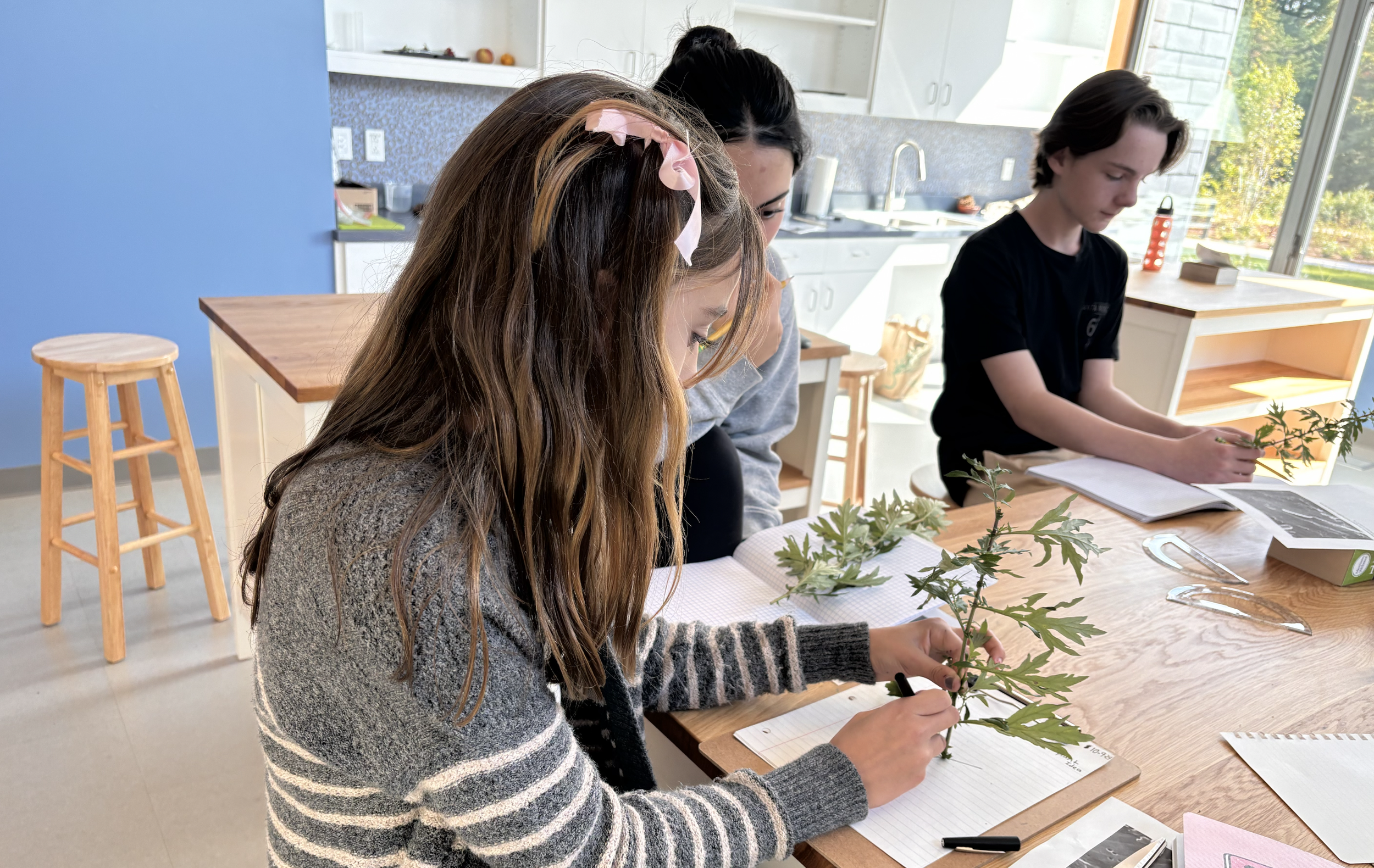
Upper School Blog
Exploring Connections: Fibonacci, the Golden Ratio, Spirals, Cells, and Sound
By Jennifer Staple-Clark, Founder and Executive Director, and Math & Science Specialist
The Fibonacci Sequence is perhaps one of the most fascinating mathematical beauties of the world. The patterns are spectacular, and our Grade 7 students explored the Golden Ratio in various fields, including botany, art, nature, DNA, and human anatomy!
Our 7th grade students began by looking at the Fibonacci numbers and discovering for themselves the pattern. Many quickly recognized the addition pattern, while others found other intriguing relationships between the numbers. They explored the sequence in pine cones and were fascinated! They divided each consecutive number by the previous one, uncovering the Golden Ratio. As they progressed, they consistently noted the ratio of approximately 1.6. The students went on to graph the relationship of the Fibonacci Sequence with the ratio that they discovered.
Our students also examined art and architecture, from Leonardo da Vinci's Renaissance paintings to the Taj Mahal. This was especially relevant for one of our students who is researching Renaissance Art for her independent project. Our students were intrigued by the consistent ratio of 1.6 in both art and architecture. They then searched for the Golden Ratio in everyday rectangles, measuring windows, door knobs, and books to find objects that also display this ratio.
The connections to anatomy were also fascinating to our students. Some measured the distance from their elbow to their fingertips and from their elbow to their wrist, revealing another instance of the Golden Ratio. They considered the spiral of the cochlea, and they even calculated that the dimensions of DNA also reflect the Golden Ratio, measuring 34 Angstroms long by 20.4 Angstroms wide. Our students discovered these DNA dimensions in Watson and Crick's 1953 publication, “A Structure for Deoxyribose Nucleic Acid”, which was printed for them to peruse.
The Fibonacci Sequence and Golden Ratio provide robust opportunity for exploring the 7th-grade level benchmarks of ratios, graphing, percents, and decimal division. Some of our students are engaged in more advanced algebra, and they examined the irrational value of the Golden Ratio, calculated as (1 + √5)/2. They calculated √5 using several approaches, including algebra, and they also used algebra to solve equations involving the Golden Ratio, calculating lengths from known measurements and unknown variables.
Along the way, our students watched the PBS NOVA documentary called “The Great Math Mystery”. They took detailed notes about the documentary which focuses on mathematics as the language of the universe, as well as the question of whether math is invented by humans. This documentary includes a robust discussion about the Fibonacci Series and other mathematical patterns and discoveries. Each student summarized the documentary, and engaged in an editing and revision process for their writing.
The Golden Ratio offers so many opportunities to discover, including the Golden Angle. After examining its application to lines, rectangles, and spirals, students translated this concept into angles within a circle. They determined the Golden Angle based on the percentages that they uncovered in rectangles displaying the Golden Ratio. Working with our horticulturist Rana Bates, they discovered that leaves on certain plants, like Mugwort from our campus, align with the Golden Angle of 137.5 degrees. One might expect leaf placement around a stem to be 1/3 of the way around the stem, at every 120 degrees, but instead, leaves typically grow on the stem in a 137.5 degree spiral! After the students’ first measurements of Mugwort leaves averaged around 141 degrees up the stem, one of our students devised a new idea for measuring the Mugwort’s leaf angles with more precision, where she suggested cutting the stem after every 3 leaves in order to trace the leaf trios more easily. Using our student’s measuring process, the Golden Angle was precisely revealed with the protractor! 137.5 degrees! Inspired by one of our students’ research projects about Renaissance Art, we then looked at some of Leonardo da Vinci’s sketches, which were the first to identify botany spirals. The mathematical beauty of nature and of the universe is incredible, inspiring, and offers so many interdisciplinary opportunities!
The Fibonacci Sequence offers endless opportunities for deeper learning, driven by our students' curiosity. Our students went on to draw the Fibonacci Spiral by creating Fibonacci Rectangles, and they added quarter-circle arcs through each square, which created the spiral effect. Through this process, they calculated areas of the squares, applied exponents, and calculated the area percentages for each of the Fibonacci Rectangles.
Next, they focused on the cochlea as a Fibonacci Spiral. At the same time, they were studying cells and cellular components, including cilia. Their interest in hearing led us to watch several short videos about sound, including a TED-Ed video on “The Science of Sound” and a fascinating electron microscope video showing the movement of the ear’s cilia. The students had many questions, ranging from the speed of the hearing process to the role of fluid in the cochlea. They engaged in mathematical explorations to delve into these wonderings. They calculated the cochlea’s volume and surface area based on its diameter and height, determined how many sound signals the auditory cortex processes in one minute, considered the benefits of the cochlea’s fluid, and delved into a variety of other mathematical thinking related to the cochlea and sound.
One of our school parents, Dr. Glenda Callendar, also visited with medical tuning forks and otoscopes. Our students learned about the Rinne test and compared sound conduction through bone and air using the tuning forks. They noted the differences in sound produced by the 128 Hz and 512 Hz forks, observing a large splash in water from the 128 Hz fork and a smaller impact from the 512 Hz. They also saw symmetrical waves created by the 128 Hz fork when it was gently placed on the water. The students had the opportunity to examine each other’s ears using the otoscope, too.
We began with the Fibonacci Sequence, and through our students’ wonderings, we’ve had so many intriguing and interesting experiences. It’s truly a joy to follow their curiosities and ideas, and to see so many student interests emerge along the way.
